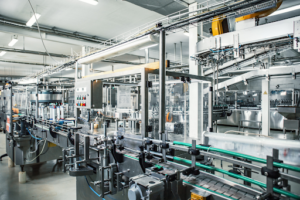Facilities everywhere are struggling to meet the high demand due to a shortage of available and willing workers, as well as proper equipment. In the past, this would have been an enormous problem – without workers and machines operating to their full efficiency, how can the job be completed?
The solution lies in industrial automation. Manufacturing facilities are turning to computers, robots, and other smart manufacturing tools to get the job done quickly and efficiently.

Source: Project Technologies and Services
For these machines to perform tasks as needed, they need to be programmed to operate like a human. This is where Programmable Logic Controllers (PLCs) come into play.
PLCs are the backbone of an automated manufacturing facility. At HESCO, we provide information on PLCs to help our customers understand why they are necessary to help modernize a facility. Let’s walk through the functionality and characterizations of a PLC, and dive into some successful PLC providers in the industry.
What is a Programmable Logic Controller (PLC)?
A PLC may be the backbone of an automated manufacturing facility, but what exactly is it?
Simply defined, a PLC is a computer designed specifically for industrial automation applications. It programs, implements, and stores industrial automation processes to ensure tasks are performed consistently and to perfection.
To simplify a PLC even further, think of it as an automatic controller – like a thermostat. Your thermostat can be programmed to increase or decrease temperature at a certain point. That’s kind of like programming a PLC. The internal workings of a PLC are controlling machines and processes around them. When properly programmed, it functions like a well-oiled machine, completing tasks that contribute to a successful and consistent manufacturing facility.

Source: Rockwell Automation
So, PLCs control machinery. But, how are they connected to that machinery? Is there a point of contact or connection?
The central point of connection between the machine and its PLC is called Input/Output (I/O). Each individual PLC can handle only a specific number of I/Os.
Let’s apply this to an example. Suppose you work in a water/wastewater facility and are looking to invest money into automating your plant. Your old systems are wearing down and the maintenance to ensure that there is consistent flow of water into the facility is becoming difficult.

Source: WaterColor Management
You explore industrial automation because it will give you an automatic solution that can control your pump flow so you can monitor water levels. After researching and consulting with providers, you determined that a PLC is the best option for what you need. Unlike your old outdated system, a PLC can automatically control the pump flow rates, which, in turn, control how much water can move in at any given time.
The PLC accomplishes this through the use of sensors, relays, and starters. With this automatic control, the plant can operate with full trust in an automatic system with no setbacks.
The needs, location, and size of PLC installations can vary greatly between facilities, and this is just one example of how PLCs can be utilized in facilities or plants.
PLC Installation: Location
Depending upon the manufacturing facility, PLCs are installed in a general area. Sometimes, PLCs are installed with control panels, and other times they are installed by themselves. But, the PLC must be in the vicinity of the machine that it is being programmed to control.
In some cases, multiple PLCs are needed, which are placed in different spaces around a facility. Depending on how many different machines need to be programmed and controlled, and if the I/Os in one PLC can handle what you are requiring, there could be multiple PLCs incorporated into your facility.
Let’s go back to our water/wastewater facility. Typically, PLCs are located on the control panels. Because of the type of facility, there is a control room, which is where the control panel is located. So, kept in a safe environment, this is where the PLC will be installed.
Varying PLC Memory Sizes
Since each facility operates differently, the memory size of the PLC can vary. The dimensions of the facility and budget for industrial automation equipment will influence the size of the PLC. On average, PLCs range from holding the memory of 3-20MB.
Additionally, the requirements of the PLCs play an enormous role in determining the size needed. Each PLC can only handle a specific number of I/Os AKA their memory. If you need to run a large machine with multiple functionalities that require different inputs, a larger PLC will likely be needed.
PLCs are incredibly essential to the industrial automation industry. Just like a remote control is the brains behind television’s operations, a PLC is the brains behind a manufacturing facility’s operations. Without a PLC, facilities would not be able to function at maximum efficiency.
Again, let’s refer to our water/wastewater facility example. Since your facility is not enormous, and is controlled by one control panel, you will only need one PLC. With a memory size of 20MB, you will have enough room to control your pump flow.
PLC Providers
If you are considering investing in industrial automation, starting with a PLC, you will want to know who can provide reliable options. At HESCO, we work with customers who either have or are purchasing all different brands of PLCs. Below are some of the brands we frequently see, both local and international. Each brand starts at just above $1,000 and increases from there depending on the PLC needed:
Allen Bradley offers PLCs from large to small to fit your needs. In production since 1970, these PLCs are a smart and scalable solution for optimal productivity.
Siemens offers PLCs, known as their SIMATIC controllers, that set new standards for simple but precise applications.
Mitsubishi is an enormous brand that offers a wide variety of products. They offer PLCs from small to large applications. Also known as their MELSEC controllers, Mitsubishi is international and can help to achieve optimal factory automation.
Schneider Electric offers PLCs to manage equipment in plants and on assembly lines. As an international company, Schneider can help industrial operations be sustainable, efficient, and flexible.
Though these are not the only PLC providers in the industry, they are most frequently seen in facilities.
So, What’s Next For Your Future PLC?
As a facility in the market for a PLC, this should help you begin investigating what you need to ensure your facility continues to operate at maximum efficiency in the coming years.
At HESCO, we can provide you with a consultation and perform an on-site visit to assist you in determining the best fit for your facility. Every facility is different and has varying needs, making it essential to contact an expert to guide you through what may be a complex and expensive transition.
